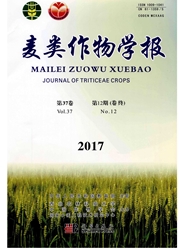

 中文摘要:
中文摘要:
为给小麦长势的遥感监测提供依据,利用多种植被指数对比分析了水浇地和旱地春小麦不同生育期冠层光谱及叶绿素含量的变化,并建立了不同地类春小麦叶绿素含量的最佳估测模型。结果表明,春小麦叶绿素含量在整个生育期呈先升后降趋势,且水浇地高于旱地。春小麦冠层光谱在可见光波段表现为阳坡和双面坡地〉阴坡地〉水浇地,而在近红外区域反之。在起身期-乳熟期,春小麦叶绿素含量分别与二次修正土壤调节植被指数和植被衰老反射率指数的相关性最好;在拔节-扬花期,水浇地和阴坡地的叶绿素含量分别与绿度植被指数和修正归一化差异指数相关性最好,阳坡和双面坡地则与二次修正土壤调节植被指数的相关系数最大。利用相关性最好的植被指数模拟春小麦叶绿素含量,水浇地在起身-扬花期宜用抛物线模型,乳熟期则适合用乘幂模型,且各模型r和检验r均大于0.88,拟合程度较高;阴坡、阳坡和双面坡地起身期适用指数模型,其余时期适合抛物线模型。
 英文摘要:
英文摘要:
To provide base for the remote sense monitoring of wheat growth, the canopy spectrum and chlorophyll content at different growth stages of wheat growing in irrigated land and dryland was analyzed using various, then the models for estimating chlorophyll content of spring wheat at different kinds of land were established The results showed that chlorophyll content of spring wheat at whole growing period increased at first and decreased subsequently, and it was higher in irrigated land than in dry land. The canopy spectral reflectance in the visible region showed in the order as: sunny and two side slop land〉 shady land〉 irrigated land, and the canopy spectral reflectance in near infrared region was opposite. At grain setting and milk stage, the leaf chlorophyll content was correlated significantly with MSAVI2 and PSRI of different land; while at jointing, heading and flowering stages, the leaf chlorophyll content was highly correlated with GNDVI and mNDI in shady and irrigated land. But its correlation coefficients in the sunny and two side slop land with MSAVI2 was the largest. The estimation models were establish using the best vegetation indices of chlorophyll content at different types of land, parabola model was suitable for irrigated land at getting up to flowering stages; and power model was suitable at milk stage with model r and test r over 0.88; exponential model was fit for shady, sunny and two side slope land at setting stage, while parabola model was the best model for the other stages.
 同期刊论文项目
同期刊论文项目
 同项目期刊论文
同项目期刊论文
 期刊信息
期刊信息
